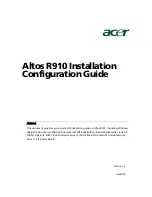Reviews:
No comments
Related manuals for PowerEdge R6515

ALTOS R910 Series
Brand: Acer Pages: 74

Univerge SV9100
Brand: NEC Pages: 78

UNIVERGE SL2100
Brand: NEC Pages: 34

SV8500
Brand: NEC Pages: 2

SV8500
Brand: NEC Pages: 975

BladeCenter S
Brand: IBM Pages: 84

9008-22L
Brand: IBM Pages: 110

eServer BladeCenter JS20 Type 8842
Brand: IBM Pages: 150

Cube YY-0430
Brand: Yeong Yang Pages: 7

STE-601C
Brand: Devolinx Pages: 51

Sun Fire V20z
Brand: Sun Microsystems Pages: 4

printWiFi
Brand: ImageTech Pages: 44

N12000 series
Brand: Thecus Pages: 120

QSSC-S99K 2U
Brand: QUANTA Pages: 177

A+ AS -2114GT-DNR
Brand: Supermicro Pages: 126

MB202
Brand: LOOQS Pages: 69

PowerEdge 6600
Brand: Dell Pages: 77

PowerEdge 6650
Brand: Dell Pages: 14

















